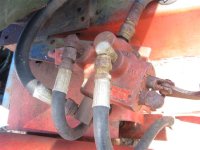juiceman39
Member
- Joined
- Jul 7, 2009
- Messages
- 33
Could someone explain whats probably basic to most of you. I have an unused control valve which was once used for a mowing deck. The in-line comes from the FEL out.The out-line goes to the tank. what would keep me from plumbing the out of the FEL control valve to the tank. Wouldnt it have to have high pressure to run the deck control valve? what knocks down the pressure so it can go to the tank is my unanswered question. Are there different "out" fittings off a control valve? If so how do you tell which is which?
steve
steve


